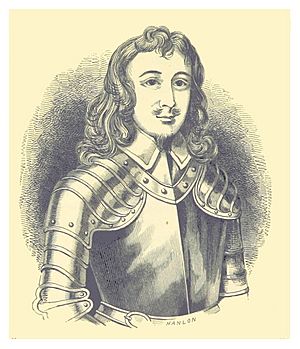Richard Grace facts for kids
Quick facts for kids
Richard Grace
|
|
|---|---|

Richard Grace, copy of 1652 engraving
|
|
| Born | ca. 1612 Ireland |
| Died | 1691 (aged about 79) Athlone, Ireland) |
| Allegiance | England (to 1642) Cavaliers (1642–53) Spain (1653– ? ) France (? –1660) England (1660–88) Jacobites (1688–91) |
| Rank | Colonel |
| Battles/wars | Battle of the Dunes (1658), Siege of Athlone |
Colonel Richard Grace (born around 1612, died 1691) was an Irish soldier. He was a Cavalier, which means he supported the King during the English Civil War. He fought for King Charles I, King Charles II, and King James II. During the 1650s, he was part of the Royalist Army in Exile, which was an army of people loyal to the king who had to leave England.
Contents
Who Was Richard Grace?
Richard Grace was born in the early 1600s in County Kilkenny, Ireland. His family was important in the area. He lived at Moyelly Castle in what was then called Queen's County (now County Laois).
Fighting for King Charles I
Grace first served King Charles I in England. He fought for the King until 1646, when the King's forces at Oxford surrendered. After this, he went back to Ireland.
The Irish Confederate Wars
In Ireland, Richard Grace joined the Irish Confederate Wars. These were a series of wars fought in Ireland during the mid-1600s. He led about 3,000 men. They often bothered the English Parliament's troops in places like Wicklow and near the River Shannon.
Life After the Wars
In 1652, the English government offered a reward of £300 for his capture. But when the war ended, he was allowed to join the Spanish army. He took 1,200 of his men with him.
Serving Other Countries
Grace fought in the Battle of the Dunes (1658) for King Charles II, who was in exile at the time. Later, he switched to the French side. He made sure to tell his Spanish friends first, so it wasn't a betrayal.
Return to England
After King Charles II returned to the throne in England (this was called the Restoration), Richard Grace was given an important job. He became the Chamberlain to the Duke of York, who later became King James II. Because of his loyal service, he received money and some of his lands back.
Defending Athlone
When King James II came to Ireland after the Glorious Revolution, he made Grace the Governor of Athlone. Grace had three regiments of soldiers and eleven troops of cavalry (horseback soldiers) under his command.
The First Siege of Athlone
After the Battle of the Boyne, General Douglas attacked Athlone with many soldiers. Grace bravely defended the town. He burned the English part of the town and broke down the bridge to stop the attackers. When asked to surrender, he famously fired a pistol and said, "These are my terms; these only will I give or receive; and when my provisions are consumed, I will defend till I eat my old boots." After a week, Douglas had to leave, having lost 400 men.
The Second Siege and Grace's Death
Athlone was attacked again in 1691 by Godert de Ginkell. Before this, the Marquis de St Ruth made Grace trade some of his experienced soldiers for less skilled French troops. Even so, Grace defended the town heroically. On June 30, 1691, after de Ginkell's forces crossed the Shannon River and captured part of the town, Colonel Grace's body was found in the ruins.
Grace's Character
People said that Grace treated Protestants in his area kindly and fairly. He was also known for his strict discipline with his soldiers, which was different from other parts of the Irish army. Despite this, his men loved him. The Grace family still exists today, but they no longer have the same social influence.
See also
- Robert Grace

